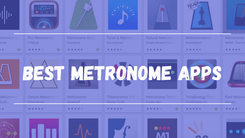
Reviewing The Best Metronome Apps Of 2023
These apps were ranked as the best metronome apps, but how good are they really? Which one is actually the best?
Tap The Button 6 Times To Get Started
This tool will help you calculate the tempo of any song. To use the tool, just tap the above button along with the beat of the song. After 6 taps, the bpm counter will display the tempo.
If you speed up, the bpm counter will show a higher tempo. If you slow down, the tempo displayed will follow. To get the most accurate bpm of a song, tap along until you get a consistent reading from the counter.
There are two ways I like to use a BPM counter.
BPM stands for "beats-per-minute." It is a way of describing the tempo of a song. A fast piece of music will have many beats per minute, whereas a slow song might have 60 or fewer beats per minute.
You can learn more about BPM here and how to develop an internal sense of time.
Tempo can be written as BPM (usually show as quarter note =), or it can be written as a tempo marking. Tempo markings are usually a few words that describe a range of tempos. For example, Adagio could be as slow as 66 or as fast as 76.
In addition to giving a range of bpm, tempo markings usually convey some character. For example, Largo and Lento can both mean a range of 40 - 60 beats per minute, but Largo also means "broadly," which suggests performing notes in a connected style.

These apps were ranked as the best metronome apps, but how good are they really? Which one is actually the best?

The major scales are the building blocks of music, mastering them is the first step to learning to play quickly in any key.

Questions you should answer before picking an instrument to learn.

Tempo markings can be written as a word, or as a number (BPM). What does that number actually mean?